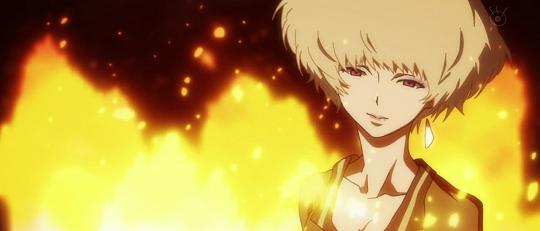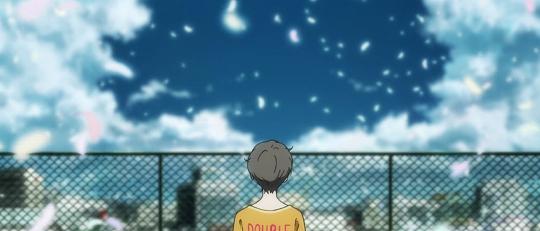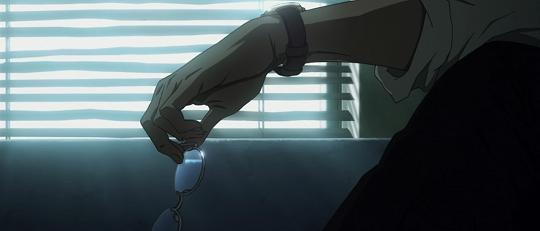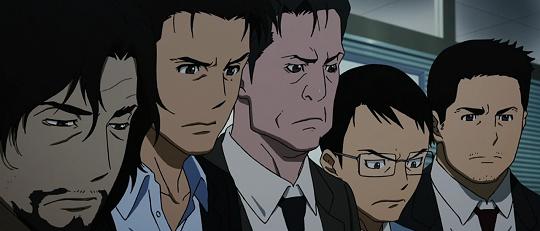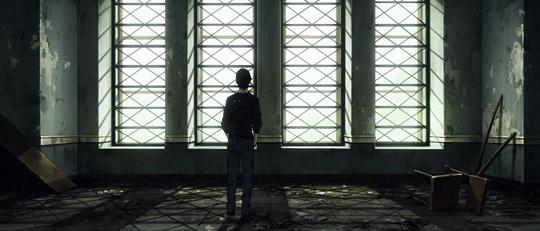It would be false to say that there are mainstream and niche anime series when anime as a medium is niche, its audience perhaps even more so. Beyond the One Piece’s, with their absurd viewership, there is a definite split between the popular, attention grabbing series - the Code Geass’, the Sword Art Online’s - and the smaller, less broadly approachable ones. Zankyou no Terror (Terror in Resonance, Terror in Tokyo) is firmly the latter, but starts out as the former.
With the bombing of the iconic Tokyo Metropolitan Government Building the first episode builds sublime tension while simultaneously introducing the principal cast members; and for the next few episodes at least, the series pitches itself as a cat-and-mouse style detective thriller, with adolescent terrorists Nine and Twelve goading the police while destroying key locations within Tokyo. Kenjirou Shibazaki, a hard-boiled but relegated detective, meanwhile might just be smart enough to catch them. What doesn’t become apparent until much later is that this structure, “catch us if you can”, is not even close to what Zankyou no Terror is about.
This poses problems because those who came along for a daring chase - will Shibazaki be able to catch these criminals before they unleash their final plan? - will be left cold. So too will those enjoying the emotional trajectory of Lisa who is trapped with an abusive home life and bullied at school, who sees Nine and Twelve as her escape. Even those looking for a more general commentary on terrorism, on the disenfranchisement of youth or the interfering jingoism of nations outside of Japan, will be left unsatisfied.
If that sounds like a lot of people left wanting, you only have to dive into the reviews elsewhere to see how tangible that sentiment is and how divisive this series became. There isn’t really an argument against that because the trademark of the storytelling here is the gulf between how much is explicitly told and how much is implicitly deduced.
Investigation
The narrative itself is easy enough to follow: Nine and Twelve, orphans, were experimented on by the government when they were young. After escaping the research facility they devised a plot to expose the project that robbed them of their youth. They do this by planting bombs, primarily to garner attention and turn the eyes of Japan towards their motives and their history. Accompanying that thread is the already mentioned Lisa, Five - another alumni of the experimentation done to Nine and Twelve - and Shibazaki - a devil-may-care police investigator who will do anything to reach the truth.
Even on a superficial level the plot dredges up real societal issues facing Japan today as well as hinting at themes of alienation and media power. It swiftly becomes obvious that this is a ferociously modern story, with talk of cryptocurrency alongside prolific mobile phone usage and social media, this is not a by-the-numbers crims-versus-cops set up. Instead you have Nine and Twelve, teenage savants, using technology to outwit and outmaneuver the police, including Shibazaki who remains staunchly analogue, still pounding the pavement and talking to witnesses. So despite razing buildings and visiting untold destruction upon Tokyo, Sphinx are lionised by Japan’s youth who buy masks to match their new idols, crowding around to avidly watch the latest video ultimatum on modern mobile phones.
Nine and Twelve however were, in a very real sense, created by the government, made geniuses through administration of drugs and enforced lifestyles. The pressure of such a school system created three ruthlessly intelligent but socially broken children trapped in bodies on the cusp of adulthood. These are not well rounded individuals but myopic, laser-guided weapons who don’t care about the fallout, both literal and figurative, if it achieves their goal.
Compare then with Shibazaki and his police contemporaries: proud, righteous and the visible frontline of decaying old men who skulk in the shadows, clinging to their fury and indignation borne in the wake of World War Two. They secretly build nuclear weapons of their own and strip-mine the country’s youth in an attempt to ameliorate the emasculation they perceive Japan is suffering.
Application
Like Kenji Kamiyama’s Eden of the East and Ghost in the Shell: Standalone Complex before it, Shinichiro Watanabe has crafted a series that, like its protagonists, attempts to drag painfully real social maladies into the spotlight. It may articulate those questions, but it doesn’t attempt to postulate answers to them. They are questions that can’t be tackled in eleven, twenty four or even fifty two episodes, so the director doesn’t try. With such a short runtime and with such a broad reaching narrative, judicious storytelling is of paramount importance, which is where the series shows the pedigree of its director.
Its odd to dissect the minutiae of direction within anime because like innumerable other media good direction is, to those not watching for it, imperceptible to merely serviceable direction. It’s easy to glue on backstory here or dip into a character’s inner monologue there, but that’s telling rather than showing. Here every shot has purpose, with contrast, colour and composition playing a massive part in the development of everyone from Shibazaki’s erstwhile partner to protagonist Nine. It’s often about the unspoken implications rather than the serving, on plates of silver, of exposition.
Unfortunately the series still does that which feels like something of an throwback; an entire episode late on is dedicated to hashing out the details of the child experimentation “research”, Project Athena. It’s sloppy storytelling but still excellent direction, getting to the heart of what a lot of drama boils down to: people, in a room, talking. The angles change just as the power within the room does with foes routed with only verbal shots fired. If there is too much exposition, then in a similar vein the grainy images from Twelve, Nine and Five’s past in the research institute are shown far too frequently, adding details to a part of the story we already know enough about.
That technique of showing rather than telling though is where my adoration for Zankyou no Terror begins. It doesn’t belittle the audience and leaves space for interpretation where it needs to rather than spelling out the conclusion. For instance, the finale never shows Nine’s death, implying that he died because of the lingering effects of the experiments - whether he died immediately or weeks later is irrelevant to the story’s outcome or the path that he and Twelve decided upon. Likewise we are never shown any kind of reconciliation between Lisa and her distraught mother either, the implication being that through her experiences with Sphinx, Lisa has grown and can confront her issues rather than trying to escape from them.
The trouble of course is that with interpretation comes dissatisfaction, and with such an alluring opening set of episodes, the number of scrutinising eyes increased. It seemed as though the series wanted the audience to be Shibazaki, to relentlessly seek the truth and solve the riddles that Sphinx placed before us; yet in reality it’s Lisa who the audience should identify with. A snapshot of modern youth with adults telling her she is nothing, useless, she becomes so wrapped up in her own problems it matters little what happens to everyone else. Destroy the world for all she cares, it would make things simpler.
Context
Of course, eventually, Nine and Twelve do destroy the world. In something of an irony their last bomb robs Japan of the technology that the pair relied on to terrorise the country in the first place. However, like when I said that Eden of the East “wasn’t for you”, the source of the terrorism that takes place here is very different to what has been seen by other parts of the world, specifically western countries such as the UK, Europe and of course, the US. Japan is historically no stranger to terrorism as a concept with a series of incidents in the 1970’s, an airport bombing in 1985, the notorious Sarin gas attack in 1995 and small-scale incidents in the first decade of 2000; but with the exception of the airport bombing, all of the noteworthy incidents have been enacted by Japanese nationals.
This doesn’t excuse or justify the destructive actions Nine and Twelve take, their motive - to send a message - is a core tenet of terrorism, but it puts a different slant on the type of society that the pair is terrorising. It is a defeated and post-apocalyptic society that traditionally champions group unity, but is facing isolation both national and personal, backed by an undercurrent of xenophobia. The story never paints the duo as heroes, both of them understand the consequences of their actions - going as far as showing them to Lisa - regardless of the precautions they take. But neither are they pitched as villains, only victims. In that sense then they are selfishly pushing the traumas that they suffered back onto the people who visited it upon them, but with the rest of the population caught in the crossfire.
It’s ugly, existing in a moral grey area, but is thankfully handled in a cold, clinical manner; but it makes that final scene, of Lisa, Twelve and Nine playing in front of the gravestones - enjoying a summer’s day as a child - all the more poignant. Did Nine and Twelve’s fire kill other children? Is this their penance, their retribution for the children killed by the research project?
Challenge
They are questions that aren’t answered by Zankyou no Terror and I love it all the more for it. I love it because it reunites Shinichiro Watanabe and Yoko Kanno and marks the first soundtrack from her in two years: as beautiful and bizarre and arresting as anything I could have hoped for. I love it because for all the searing summer sunshine, it isn’t afraid to ramp up the contrast and let the saturated sky drown the stifling shadows. I love it because despite all the explosions and the clamour of the city, it isn’t afraid of being quiet and letting the visuals sink in.
Zankyou no Terror is a series that before watching each episode, I would turn off the lights, turn up the volume and settle in to be gripped for twenty four minutes. It is imperfect and daring and intelligent and, somewhat simplistically, my sort of show. As I’ve said before, expectation will greatly define your enjoyment of the series; but more so than others, Zankyou no Terror builds a rod for its own back by starting with such a superbly tense and enticing concept. That it finishes with the same, but for an entirely different reason, is up for interpretation. It’s a series that deserves to be watched for the craftsmanship that went into its direction, its score and its aesthetics but also for the simple reason that it’s damn good, through and through.
